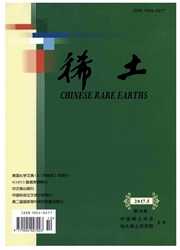

 中文摘要:
中文摘要:
对La0.9Ce0.1Fe11.44Si1.56合金进行饱和吸氢,之后在不同放氢温度(Td=200~250℃)下进行3 h放氢处理,得到H含量不同即具有不同Curie温度(TC)的氢化物,对其相结构和磁热效应进行测试分析.结果表明,合金在吸氢前后有相同的相结构,主相为Na Zn13型立方结构,同时含有少量a-Fe杂相;随着放氢温度的提高,TC近似线性的降低;由于H原子的引入消弱了一级巡游电子变磁(IEM)转变,等温磁熵变较母合金有所降低,当Td〉230℃时,磁熵变随着放氢温度的升高明显降低,磁滞减小,当Td=250℃时,磁熵变曲线宽化,一级相变特性弱化.饱和吸氢后的La0.9Ce0.1Fe11.44Si1.56Hy粉末经固化后得到的粘结样品在0~1.5 T的磁场下,绝热温变和等温磁熵变的最大值分别达到2.7 K和7.5 J/(kg·K).
 英文摘要:
英文摘要:
Recently, La(Fe, Si)~3-based magnetic refrigeration materials have been widely explored due to the advantages of giant magnetocaloric effect (MCE), tunable Curie temperature (Tc), low cost of raw materials and excluding deleterious elements compared to other room-temperature giant MCE materials such as Gd,(Ge1-xSix)4, MnFeP0.45As0.55 and MnAs based compounds. In this work, in order to shift the Tc to around room temperature and maintain the large MCE, the method of absorbing hydrogen was employed La0.9Ce0.1Fe11.44Si1.56 hydride was pre- pared by saturated hydrogen absorption and then hydrogen contents and Tc of the hydrides were controlled by sub- sequent dehydrogenation at different temperatures (Td=200-250℃ for 3 h). The phase structure and magnetocalo- ric effect were investigated. The results show that the samples possess the cubic NaZn13-type structure with a small amount of a-Fe as impurity phase. Tc exhibits an approximately linear decrease with increasing the dehydrogena- tion temperature. The isothermal magnetic entropy change (△Sm) of the hydrides decreases compared with the parent compound, which is mainly attributed to the fact that the field-induced itinerant-electron metamagnetic transition has been weakened upon hydrogen absorption. For the sample desorbed hydrogen at temperatures above 230℃, ASm is remarkably decreased and favorably the magnetic hysteresis loss has been reduced simultaneously. With further increasing the temperature to 250℃, △Sm, curve is broadened, weakening the characteristic of the first-order phase transition. Due to the intrinsic brittleness of hydrides, the preparation of a certain shape is of great importance for practical application. For a magnetic field change of 1.5 T, the maximum adiabatic temperature change (△Tad) and ASm for the bonded block of fully hydrogen absorption La0.9Ce0.1Fe11.44Si1.56 hydride are about 2.7 K and 7.5 J/(kg. K), respectively, which are larger than those of La(Fe, Co, Si)13 materials in the same
 同期刊论文项目
同期刊论文项目
 同项目期刊论文
同项目期刊论文
 期刊信息
期刊信息
